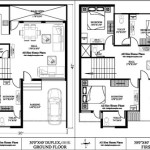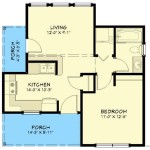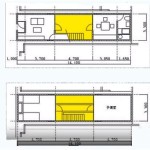Floor Plans For Houses: A Comprehensive Overview
When embarking on the journey of designing or remodeling a house, one of the most crucial aspects is developing a well-conceived floor plan. A floor plan serves as a blueprint for the home's layout, defining the arrangement and dimensions of each room, as well as their interconnections. A meticulously crafted floor plan can optimize the functionality, comfort, and overall appeal of a house. ### Types of Floor Plans Depending on the architectural style, personal preferences, and functional requirements, floor plans can vary significantly. Some of the most common types of floor plans include: 1.Single-Story Floor Plans:
- These layouts are designed for homes with all living spaces situated on a single level. - They are often favored for their accessibility, ease of movement, and compact design. 2.Two-Story Floor Plans:
- Consisting of two primary levels, these plans offer distinct living and sleeping areas. - Typically, the ground floor comprises the living room, kitchen, dining area, and possibly a bedroom, while the upper level features bedrooms and bathrooms. 3.Multi-Level Floor Plans:
- These designs encompass multiple levels, including basements, attics, or other intermediate floors. - They provide ample space for various activities and can accommodate additional bedrooms, family rooms, or recreational areas. 4.Open Floor Plans:
- Open floor plans prioritize spacious, interconnected living areas with minimal walls or barriers. - They create a sense of openness and flow, promoting interaction and communication among family members. 5.Split-Level Floor Plans:
- These plans feature distinct living areas separated by half-levels. - They provide a sense of separation and privacy while maintaining a cohesive layout. ### Key Considerations for Floor Plan Design When designing a floor plan, numerous factors come into play, including: 1.Functionality and Traffic Flow:
- The layout should facilitate smooth movement within the house, minimizing traffic congestion and maximizing efficiency. - Clear pathways and well-defined spaces for different activities enhance convenience and comfort. 2.Room Sizes and Proportions:
- Determining appropriate dimensions for each room is essential for comfort and functionality. - Proportions should be visually appealing and conducive to furniture placement and circulation. 3.Privacy and Separation:
- Balancing open spaces with private areas is crucial for creating a harmonious living environment. - Bedrooms and bathrooms should offer privacy, while common areas can promote interaction and togetherness. 4.Lighting and Ventilation:
- Natural light and proper ventilation play a significant role in creating a healthy and comfortable living environment. - Windows and skylights should be strategically placed to maximize natural light and cross-ventilation. 5.Storage Solutions:
- Incorporating ample storage space into the floor plan ensures orderliness and functionality. - Closets, built-in cabinets, and other storage options keep belongings organized and accessible. ### Benefits of Well-Designed Floor Plans A well-conceived floor plan offers several advantages: 1.Enhanced Functionality:
- A thoughtfully designed layout optimizes functionality, making daily activities more efficient and convenient. 2.Improved Comfort and Livability:
- A floor plan that caters to the needs and preferences of the occupants enhances comfort and overall livability. 3.Increased Resale Value:
- A well-designed floor plan can significantly boost a home's resale value by making it more attractive to potential buyers. 4.Energy Efficiency:
- Floor plans that incorporate energy-efficient features, such as proper insulation and strategically placed windows, can help reduce energy consumption and utility bills. ### Conclusion Floor plans serve as the foundation for creating homes that are not only aesthetically pleasing but also functional, comfortable, and energy-efficient. By carefully considering various factors and incorporating innovative design elements, homeowners can create floor plans that perfectly suit their needs and preferences. Whether opting for a single-story, two-story, or multi-level design, open floor plan, or split-level layout, a well-executed floor plan can transform a house into a haven of comfort, convenience, and style.
House Plans How To Design Your Home Plan

House Plans How To Design Your Home Plan

House Plans How To Design Your Home Plan

House Plans Home Floor Architecturalhouseplans Com

Floor Plans Types Symbols Examples

Vatican Mansion Floor Plans Two Story

How Much Do 3d House Plans Cost Faqs Answered Cedreo

Importance Of House Floor Plans In Architectural Design

House Plans Floor Blueprints

Where You Can Buy House Plans Live Home 3d








